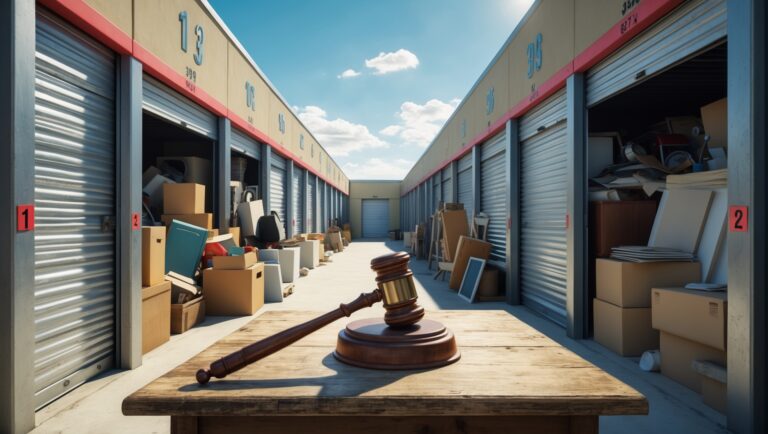Self-Storage Facility Landscaping: Cost-Effective Curb Appeal and Maintenance Strategies
Introduction: Why Landscaping Matters for Self-Storage Facilities
When it comes to running a successful self-storage facility, landscaping might not be the first thing that comes to mind. Yet, the exterior appearance of your property plays a pivotal role in attracting tenants, conveying professionalism, and maintaining property value. Clean, well-maintained grounds signal safety, trustworthiness, and quality service—key decision factors for prospective renters. However, for many facility owners and managers, landscaping often feels like an afterthought or an unnecessary expense.
The reality is that strategic landscaping can be both cost-effective and low-maintenance, offering substantial returns on investment. Well-designed grounds not only enhance curb appeal but can also reduce long-term maintenance costs, deter crime, and prevent costly issues like drainage or pest problems. In this comprehensive guide, we’ll explore practical, budget-friendly landscaping strategies perfectly suited for self-storage businesses. From plant selection and water management to seasonal upkeep and security integration, you’ll find actionable advice to make your property stand out without breaking the bank.
Understanding the Unique Landscaping Needs of Storage Facilities
The Functional Role of Landscaping
Landscaping for self-storage facilities is less about lush gardens and more about function and first impressions. Unlike residential or retail properties, your primary landscaping goals are:
- Projecting a clean, professional image
- Minimizing ongoing maintenance
- Controlling costs
- Enhancing security and visibility
- Complying with municipal codes and environmental regulations
Common Challenges
Self-storage properties often cover large areas with limited budgets for groundskeeping. Challenges include:
- Vandalism and unauthorized access
- Weed, pest, and rodent control
- Harsh climate or drought conditions
- Drainage issues
- Visibility for surveillance cameras and lighting
Addressing these issues with the right landscaping plan is crucial for long-term success.
Planning: Assess Before You Invest
Site Evaluation
Before making any changes, walk your property and take note of these key factors:
- Existing vegetation and its condition
- Problem areas (e.g., erosion, standing water, overgrown weeds)
- Visibility from the street and signage
- Access points, pathways, and parking areas
- Current irrigation systems (if any)
Photograph trouble spots and areas with potential for improvement. Consult your local city or county code for landscaping requirements—some municipalities mandate a minimum amount of green space or specify allowable plant types.
Budgeting for Impact
Set a realistic budget focused on high-visibility areas first (entrance, street frontage, office). Allocate funds for:
- Initial plantings, soil amendments, and mulching
- Hardscape updates (gravel, edging, pathways)
- Irrigation adjustments or upgrades
- Annual maintenance (weeding, trimming, repairs)
Remember: Upfront investments in quality materials and design will save money on repairs and maintenance down the line.
Low-Maintenance Plant Selection: What Works Best
Drought-Tolerant and Native Plants
Opting for drought-resistant and native plants is a proven strategy for reducing watering needs and maintenance. These species are adapted to your local climate, resist pests, and require less fertilizer. Here are some examples:
- Southwest US: Agave, yucca, sage, ornamental grasses
- Southeast US: Wax myrtle, holly, muhly grass
- Northern US: Juniper, boxwood, sedum, daylilies
- Coastal areas: Sea oats, rosemary, pittosporum
Evergreens and Groundcovers
Mixing evergreens with hardy groundcovers (such as creeping juniper, liriope, or vinca) maintains a tidy, year-round appearance with minimal upkeep. Groundcovers also help suppress weeds and control erosion on slopes.
Avoiding Problematic Plants
- Skip species that drop messy berries, pods, or sap
- Avoid fast-growing trees that damage pavement or structures with roots
- Be wary of invasive species—stick to local recommendations
Mulching, Hardscapes, and Weed Barriers
Mulch: More Than Just Looks
Mulching beds with bark chips, pine needles, or gravel offers multiple benefits:
- Suppresses weeds
- Retains soil moisture
- Improves curb appeal with a clean look
- Protects plant roots from temperature extremes
Renew mulch annually in high-visibility areas. For a more permanent solution, consider landscape fabric beneath gravel or stone in non-plant areas.
Smart Hardscaping Choices
Install edging (plastic, metal, or stone) to separate beds from driveways and walkways, reducing the spread of mulch and keeping mowing simple. Use gravel or pavers for footpaths, especially where customers walk between office and storage units.
Weed Control Tactics
- Apply pre-emergent herbicides early in the growing season
- Spot treat perennial weeds with post-emergent sprays (always follow local regulations)
- Inspect and replace damaged landscape fabric as needed
Water Management: Irrigation and Drainage Solutions
Efficient Irrigation Systems
Automated drip irrigation or soaker hoses are ideal for targeted watering, reducing waste and avoiding overspray onto buildings or driveways. Key tips:
- Water early in the morning to minimize evaporation
- Group plants by watering needs to avoid over- or under-watering
- Install rain sensors to avoid watering during wet weather
Drought-Proofing the Property
In drought-prone regions, consider:
- Expanding non-plant areas with decorative gravel or decomposed granite
- Using rain barrels or cisterns for supplemental irrigation
- Applying mulch generously to preserve soil moisture
Drainage Essentials
Poor drainage can erode landscaping, undermine pavement, and create unsightly mud or standing water. Ensure that:
- Gutters and downspouts direct water away from foundations and walkways
- Grading slopes away from buildings
- French drains or swales are installed in persistent wet areas
Regularly inspect and clean drainage systems, especially after storms.
Security-Driven Landscaping
Lighting and Sight Lines
Landscaping should enhance—not hinder—security. Design plantings to preserve clear sight lines for surveillance cameras and lighting. Avoid dense shrubs or trees near fence lines, entry points, or blind spots. Good strategies include:
- Planting low-growing shrubs under windows and along perimeters
- Pruning trees and bushes regularly to maintain visibility
- Choosing open-branching trees that do not block lights or cameras
Natural Barriers
Consider using thorny or dense shrubs (such as barberry or holly) under windows or along fences as natural deterrents to trespassers—without creating hiding places. Maintain these regularly to avoid overgrowth.
Seasonal Maintenance Checklist
Spring
- Inspect irrigation and drainage systems for winter damage
- Refresh mulch, clean up debris, and prune as needed
- Apply pre-emergent weed control
Summer
- Monitor irrigation schedules
- Spot-weed and deadhead flowering plants
- Check for pest or disease issues
Fall
- Remove leaves and debris from gutters and beds
- Prune shrubs and trees to maintain shape and security sight lines
- Install winter mulch if needed
Winter
- Inspect for storm damage
- Plan spring plantings and repairs
- Monitor for ice or snow buildup along pathways
Integrating Landscaping With Marketing
Curb Appeal as a Marketing Tool
Attractive landscaping can be a powerful differentiator in a competitive market. Showcase before-and-after photos on your website and social media. Highlight environmentally friendly choices—such as native plants or water-wise design—to appeal to eco-conscious renters. Clean, inviting grounds also make a strong impression on drive-by prospects.
Signage and Branding
Frame signage with well-maintained beds or decorative boulders. Use consistent color schemes with plantings and hardscape materials to reinforce your brand identity. Avoid plantings that may obscure signs or block the view from the street.
Cost Breakdown: Budgeting for Installation and Upkeep
Installation Costs
Typical costs for a small-to-medium facility (1-3 acres):
- Initial plantings and mulch: $2,000–$8,000 (higher for premium materials or extensive beds)
- Hardscape additions (gravel, edging, pavers): $1,000–$5,000
- Irrigation upgrades: $2,000–$6,000 (drip or soaker systems)
DIY installation can save up to 30% compared to hiring a professional landscaper, but may require more time and effort up front.
Annual Maintenance Costs
- Mulch refresh, pruning, weed control, irrigation checks: $1,000–$3,000 per year
- Factor in occasional replacement of plants, mulch, or hardscape repairs
Tip: Many facility owners find a hybrid approach of professional spring/fall cleanups and DIY summer maintenance to be most cost-effective.
Vendor Selection and DIY Tips
Choosing the Right Landscaping Service
Look for companies with experience in commercial or industrial properties. Ask for references and photos of similar projects. Clarify:
- Scope of work and frequency of visits
- Responsiveness to emergencies (e.g., storm cleanup)
- Familiarity with local codes and water restrictions
DIY Landscaping Tips
- Invest in basic tools: mulch forks, wheeled carts, hedge trimmers
- Install mulch and groundcovers yourself to reduce costs
- Stagger plantings over multiple seasons to spread out expenses
- Leverage community volunteer days or local gardening clubs for larger projects
Compliance and Environmental Considerations
Staying Code-Compliant
Check local ordinances regarding:
- Minimum green space requirements
- Permitted plant types (especially in fire-prone or drought areas)
- Height restrictions for hedges or trees
- Use of herbicides and pesticides
Non-compliance can result in fines or forced removal of non-conforming landscaping.
Sustainability Practices
- Use organic mulch and minimize chemical usage
- Choose plants that support local pollinators
- Install rain sensors and drip irrigation to conserve water
- Recycle yard debris as compost or mulch
Case Study: Transforming a Drab Facility Into a Standout
Consider “BrightBox Storage,” a 2-acre facility on a busy suburban road. Originally, the grounds were mostly cracked pavement and patchy weeds, creating a neglected impression. After a thoughtful landscaping overhaul:
- Street frontage was reworked with drought-tolerant shrubs and decorative boulders
- Mulched beds replaced grass along fence lines, drastically cutting mowing time
- Solar path lights and low-growing junipers improved both security and appearance
- A drip irrigation system replaced outdated sprinklers, cutting water bills by 40%
- Maintenance costs dropped by $1,500 per year, with staff able to keep up with seasonal tasks in-house
The result? A 20% increase in walk-in inquiries within the first year and improved tenant satisfaction scores. This example proves that smart landscaping is a valuable investment for any storage operation.
Conclusion: Landscaping as a Long-Term Asset
Landscaping is so much more than window dressing for your self-storage facility—it’s an investment in your business’s reputation, operational efficiency, and long-term profitability. Thoughtful, well-planned landscapes not only attract tenants and instill confidence but also reduce maintenance headaches and operating costs. By focusing on low-maintenance, native plants, effective mulching, and strategic hardscaping, you create a property that’s both appealing and practical.
Remember, the best landscaping solutions are those tailored to your unique site conditions, climate, and business goals. Start with a clear-eyed assessment, prioritize visibility and security, and budget for both installation and ongoing upkeep. Integrate your landscaping improvements into your marketing strategy, showcasing your pride of ownership and attention to detail. Whether you tackle the work yourself or partner with experienced vendors, regular seasonal maintenance will keep your grounds looking sharp year-round.
In the end, embracing landscaping as a core part of your facility management not only sets you apart from the competition but also pays dividends in customer satisfaction and operational savings. With the right approach, your exterior spaces can become a genuine asset—boosting your bottom line while making a lasting impression on every client who visits your facility.






